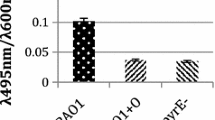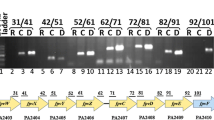Abstract
Proteins encoded by the Pseudomonas aeruginosa pvcA-D operon synthesize a novel isonitrile functionalized cumarin termed paerucumarin. The pvcA-D operon enhances the expression of the P. aeruginosa fimbrial chaperone/usher pathway (cup) genes and this effect is mediated through paerucumarin. Whether pvcA-D and/or paerucumarin affect the expression of other P. aeruginosa genes is not known. In this study, we examined the effect of a mutation in pvcA-D operon the global transcriptome of the P. aeruginosa strain PAO1-UW. The mutation reduced the expression of several ironcontrolled genes including pvdS, which is essential for the expression of the pyoverdine genes. Additional transcriptional studies showed that the pvcA-D operon is not regulated by iron. Exogenously added paerucumarin enhanced pyoverdine production and pvdS expression in PAO1-UW. Iron-chelation experiments revealed that purified paerucumarin chelates iron. However, exogenously added paerucumarin significantly reduced the growth of a P. aeruginosa mutant defective in pyoverdine and pyochelin production. In contrast to other secondary metabolite, Pseudomonas quinolone signal (PQS), paerucumarin is not localized to the P. aeruginosa membrane vesicles. These results suggest that paerucumarin enhances the expression of iron-controlled genes by chelating iron within the P. aeruginosa extracellular environment. Although paerucumarin chelates iron, it does not function as a siderophore. Unlike PQS, paerucumarin is not associated with the P. aeruginosa cell envelope.
Similar content being viewed by others
References
Anzaldi, L.L. and Skaar, E.P. 2010. Overcoming the heme paradox: heme toxicity and tolerance in bacterial pathogens. Infect. Immun. 78, 4977–4989.
Benjamini, Y. and Hochberg, Y. 1995. Controlling the false discovery rate: a practical and powerful approach to multiple testing. J. Roy. Stat. Soc. B 57, 289–300.
Church, D., Elsayed, S., Reid, O., Winston, B., and Lindsay, R. 2006. Burn wound infections. Clin. Microbiol. Rev. 19, 403–434.
Clarke-Pearson, M.F. and Brady, S.F. 2008. Paerucumarin, a new metabolite produced by the pvc gene cluster from Pseudomonas aeruginosa. J. Bacteriol. 190, 6927–6930.
Cornelis, P. 2010. Iron uptake and metabolism in pseudomonads. Appl. Microbiol. Biotechnol. 86, 1637–1645.
Cornelis, P., Matthijs, S., and Van Oeffelen, L. 2009. Iron uptake regulation in Pseudomonas aeruginosa. Biometals 22, 15–22.
Diggle, S.P., Matthijs, S., Wright, V.J., Fletcher, M.P., Chhabra, S.R., Lamont, I.L., Kong, X., Hider, R.C., Cornelis, P., Camara, M., et al. 2007. The Pseudomonas aeruginosa 4-quinolone signal molecules HHQ and PQS play multifunctional roles in quorum sensing and iron entrapment. Chem. Biol. 14, 87–96.
Donlan, R.M. and Costerton, J.W. 2002. Biofilms: survival mechanisms of clinically relevant microorganisms. Clin. Microbiol. Rev. 15, 167–193.
Driscoll, J.A., Brody, S.L., and Kollef, M.H. 2007. The epidemiology, pathogenesis and treatment of Pseudomonas aeruginosa infections. Drugs 67, 351–368.
Engel, J. and Balachandran, P. 2009. Role of Pseudomonas aeruginosa type III effectors in disease. Curr. Opin. Microbiol. 12, 61–66.
Ghysels, B., Dieu, B.T., Beatson, S.A., Pirnay, J.P., Ochsner, U.A., Vasil, M.L., and Cornelis, P. 2004. FpvB, an alternative type I ferripyoverdine receptor of Pseudomonas aeruginosa. Microbiology 150, 1671–1680.
Gibson, R.L., Burns, J.L., and Ramsey, B.W. 2003. Pathophysiology and management of pulmonary infections in cystic fibrosis. Am. J. Respir. Crit. Care Med. 168, 918–951.
Hamood, A.N., Colmer, J.A., and Carty, N.L. 2004). Regulation of Pseudomonas aeruginosa exotoxin A synthesis. In Ramos, J.L. (ed.), Pseudomonas: Virulence and gene regulation, pp. 389–423. Kluwer Academic/Plenum Publishers, NY, USA.
Hamood, A.N., Colmer, J.A., Ochsner, U.A., and Vasil, M.L. 1996. Isolation and characterization of a Pseudomonas aeruginosa gene, ptxR, which positively regulates exotoxin A production. Mol. Microbiol. 21, 97–110.
Holloway, B.W., Krishnapillai, V., and Morgan, A.F. 1979. Chromosomal genetics of Pseudomonas. Microbiol. Rev. 43, 73–102.
Imperi, F., Tiburzi, F., and Visca, P. 2009. Molecular basis of pyoverdine siderophore recycling in Pseudomona aeruginosa. Proc. Natl. Acad. Sci. USA 106, 20440–20445.
Jacobs, M.A., Alwood, A., Thaipisuttikul, I., Spencer, D., Haugen, E., Ernst, S., Will, O., Kaul, R., Raymond, C., Levy, R., et al. 2003. Comprehensive transposon mutant library of Pseudomonas aeruginosa. Proc. Natl. Acad. Sci. USA 100, 14339–14344.
Leid, J.G., Willson, C.J., Shirtliff, M.E., Hassett, D.J., Parsek, M.R., and Jeffers, A.K. 2005. The exopolysaccharide alginate protects Pseudomonas aeruginosa biofilm bacteria from IFN-?-mediated macrophage killing. J. Immunol. 175, 7512–7518.
Lyczak, J.B., Cannon, C.L., and Pier, G.B. 2002. Lung infections associated with cystic fibrosis. Clin. Microbiol. Rev. 15, 194–222.
Mashburn, L.M. and Whiteley, M. 2005. Membrane vesicles traffic signals and facilitate group activities in a prokaryote. Nature 437, 422–425.
Matsukawa, M. and Greenberg, E.P. 2004. Putative exopolysaccharide synthesis genes influence Pseudomonas aeruginosa biofilm development. J. Bacteriol. 186, 4449–4456.
Nairz, M., Schroll, A., Sonnweber, T., and Weiss, G. 2010. The struggle for iron - a metal at the host-pathogen interface. Cell. Microbiol. 12, 1691–1702.
Ochsner, U.A. and Vasil, M.L. 1996. Gene repression by the ferric uptake regulator in Pseudomonas aeruginosa: cycle selection of iron-regulated genes. Proc. Natl. Acad. Sci. USA 93, 4409–4414.
Ochsner, U.A., Vasil, A.I., and Vasil, M.L. 1995. Role of the ferric uptake regulator of Pseudomonas aeruginosa in the regulation of siderophores and exotoxin A expression: purification and activity on iron-regulated promoters. J. Bacteriol. 177, 7194–7201.
Ochsner, U.A., Wilderman, P.J., Vasil, A.I., and Vasil, M.L. 2002. GeneChip® expression analysis of the iron starvation response in Pseudomonas aeruginosa: identification of novel pyoverdine biosynthesis genes. Mol. Microbiol. 45, 1277–1287.
Ohman, D.E., Sadoff, J.C., and Iglewski, B.H. 1980. Toxin A-deficient mutants of Pseudomonas aeruginosa PA103: isolation and characterization. Infect. Immun. 28, 899–908.
Pesci, E.C., Milbank, J.B., Pearson, J.P., McKnight, S., Kende, A.S., Greenberg, E.P., and Iglewski, B.H. 1999. Quinolone signaling in the cell-to-cell communication system of Pseudomonas aeruginosa. Proc. Natl. Acad. Sci. USA 96, 11229–11234.
Pier, G.B. and Ramphal, R. 2010). Pseudomonas aeruginosa. In Mandell, G.L., Bennett, J.E., and Dolin, R. (eds.), Mandell, Douglas, and Bennett’s Principles and Practice of Infectious Diseases, pp. 2835–2860. Churchill Livingstone Philadelphia, UK.
Qaisar, U., Luo, L., Haley, C.L., Brady, S.F., Carty, N.L., Colmer-Hamood, J.A., and Hamood, A.N. 2013. The pvc operon regulates the expression of the Pseudomonas aeruginosa fimbrial chaperone/ usher pathway (cup) genes. PLoS One 8, e62735.
Rafla, K. and Tredget, E.E. 2011. Infection control in the burn unit. Burns 37, 5–15.
Reiner, A., Yekutieli, D., and Benjamini, Y. 2003. Identifying differentially expressed genes using false discovery rate controlling procedures. Bioinformatics 19, 368–375.
Sadikot, R.T., Blackwell, T.S., Christman, J.W., and Prince, A.S. 2005. Pathogen-host interactions in Pseudomonas aeruginosa pneumonia. Am. J. Respir. Crit. Care Med. 171, 1209–1223.
Schwyn, B. and Neilands, J.B. 1987. Universal chemical assay for the detection and determination of siderophores. Anal. Biochem. 160, 47–56.
Stintzi, A., Johnson, Z., Stonehouse, M., Ochsner, U., Meyer, J.M., Vasil, M.L., and Poole, K. 1999. The pvc gene cluster of Pseudomonas aeruginosa: role in synthesis of the pyoverdine chromophore and regulation by PtxR and PvdS. J. Bacteriol. 181, 4118–4124.
Stover, C.K., Pham, X.Q., Erwin, A.L., Mizoguchi, S.D., Warrener, P., Hickey, M.J., Brinkman, F.S., Hufnagle, W.O., Kowalik, D.J., Lagrou, M., et al. 2000. Complete genome sequence of Pseudomonas aeruginosa PAO1, an opportunistic pathogen. Nature 406, 959–964.
Tashiro, Y., Ichikawa, S., Nakajima-Kambe, T., Uchiyama, H., and Nomura, N. 2010. Pseudomonas quinolone signal affects membrane vesicle production in not only Gram-negative but also Grampositive bacteria. Microbes Environ. 25, 120–125.
van Delden, C. 2004). Virulence factors in Pseudomonas aeruginosa. In Ramos, J.L. (ed.), Pseudomonas: Virulence and gene regulation, pp. 3–45. Kluwer Academic/Plenum Publishers, NY, USA.
Visca, P., Bonchi, C., Minandri, F., Frangipani, E., and Imperi, F. 2013. The dual personality of iron chelators: growth inhibitors or promoters? Antimicrob. Agents Chemother. 57, 2432–2433.
Wang, J. and Pantopoulos, K. 2011. Regulation of cellular iron metabolism. Biochem. J. 434, 365–381.
Wilson, M.J., McMorran, B.J., and Lamont, I.L. 2001. Analysis of promoters recognized by PvdS, an extracytoplasmic-function sigma factor protein from Pseudomonas aeruginosa. J. Bacteriol. 183, 2151–2155.
Winsor, G.L., Van Rossum, T., Lo, R., Khaira, B., Whiteside, M.D., Hancock, R.E., and Brinkman, F.S. 2009. Pseudomonas Genome Database: facilitating user-friendly, comprehensive comparisons of microbial genomes. Nucleic Acids Res. 37, D483–D488.
Author information
Authors and Affiliations
Corresponding author
Additional information
Supplemental material for this article may be found at http://www.springerlink.com/content/120956
Electronic supplementary material
Rights and permissions
About this article
Cite this article
Qaisar, U., Kruczek, C.J., Azeem, M. et al. The Pseudomonas aeruginosa extracellular secondary metabolite, Paerucumarin, chelates iron and is not localized to extracellular membrane vesicles. J Microbiol. 54, 573–581 (2016). https://doi.org/10.1007/s12275-016-5645-3
Received:
Revised:
Accepted:
Published:
Issue Date:
DOI: https://doi.org/10.1007/s12275-016-5645-3




